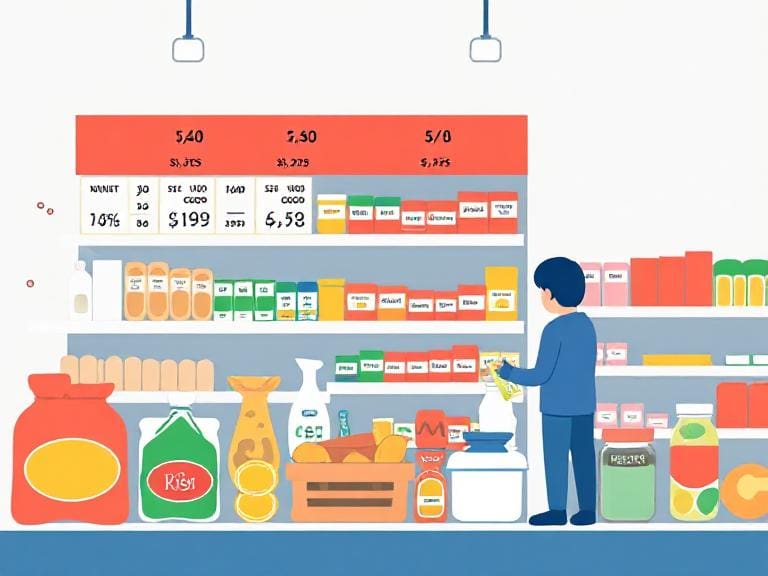The impact of prices and inflation on average household costs
The ALTAX study on household spending and purchasing power in Albania (2023–2025) provides a detailed overview of how inflation and price changes have affected consumption structure and the affordability of living for Household Economic Units (HEUs). In a period characterized by relative macroeconomic stabilization but persistent inflationary pressures, the analysis identifies distinctions between basic and non-essential expenditures, as well as clear divides between urban and rural areas.
Our analysis highlights key trends emerging from INSTAT data, offering a critical interpretation of the real dynamics of purchasing power.
Evolution of spending and consumption structure
Between 2023 and 2024, household spending experienced moderate increases, but with uneven distribution across consumption categories. Basic goods such as food, housing, and energy maintained relative stability, with increases below 2%, signaling a manageable level of core inflation. Meanwhile, non-essential categories such as furnishing, transport, entertainment, and restaurants saw increases of 4–6%, reflecting shifts in consumer behavior and a gradual expansion of urban consumption.
Transport, which rose by 5.1%, and furnishing, up by 5.6%, show the direct impact of international prices and the expansion of urban services. In real terms, spending on basic goods remains dominant, accounting for about 40% of the average household budget, indicating that despite growth in non-essential consumption, the fundamental structure of Albanian household life remains dependent on food and energy.
Balance between nominal and real stability
The comparative table for 2023–2024 shows that nominal spending increases do not automatically translate into a real improvement in living standards. The contrast between the stability of basic goods and the rise in spending for optional categories reveals an economic duality. Low-income families maintain survival-level budgets, not truly benefiting from nominal increases, while urban and higher-income families shift consumption toward quality and lifestyle improvements.
This divide reflects a dual economy in transition, where nominal growth does not generate real gains for all segments, but only for those able to diversify their expenditures.
Inflation as a “neutralizer” of nominal growth
At the core of the analysis lies the finding that inflation acts as a neutralizing mechanism, offsetting the positive effects of nominal income growth. While families may spend more, their real consumption power remains limited, as much of the budget increase is absorbed by higher prices.
For basic goods, real growth is nearly zero, while for non-essential goods it is moderate but concentrated among urban households. Low-income families remain the most exposed, feeling the brunt of rising food and energy prices. In the absence of wage and pension indexation policies, nominal increases fail to compensate for the real loss of purchasing power.
2025 outlook: continued pressure on household budgets
According to ALTAX projections for 2025, the monthly spending of an HEU with 3.1 members is expected to exceed 94,000 ALL, up from 93,042 ALL in 2024, a modest increase, but one with a tangible impact on affordability. The 2025 trends can be summarized in three main directions: a moderate rise in food and energy prices maintaining pressure on essential goods; urban growth in non-essential consumption reflecting a shift toward relative well-being but deepening inequality; and persistent transport and mobility costs as a dominant factor driving total household spending upward.
These signals suggest that the Albanian household economy is transitioning from survival toward cautious stability, but without guarantees for sustainable improvement in the absence of real income policies.
Social and economic implications
From the ALTAX analytical perspective, several key issues emerge. For low-income families, inflation remains a constant threat eroding consumer capacity and increasing dependence on public support. For urban families, expanded consumption signals growing economic confidence and lifestyle change, yet it also brings higher fixed costs that may become unsustainable in the event of economic shocks.
Pensioners and fixed-income households are the most exposed to energy and food price increases, calling for dynamic indexation policies and targeted social support. Without an integrated fiscal and social approach, nominal income growth will not translate into real improvements in living standards but will merely preserve an economic survival balance.
Toward a new economic reality
The 2023–2025 household spending analysis reveals a gradual transformation in Albania’s consumption economy: stability in basic goods signaling careful inflation management; rising non-essential consumption reflecting expanding consumer capacity and improved urban living standards; and persistent pressure on real purchasing power underscoring the need for proactive income and social protection policies.
In essence, Albanians are spending more, but not truly living better, a synthesis that captures the fragile equilibrium between steady inflation, shifting consumption patterns, and the lack of real improvement in purchasing power.



Leave a Reply
You must be logged in to post a comment.